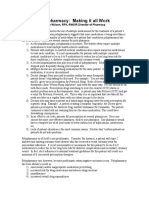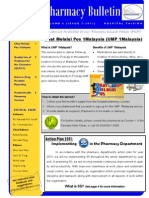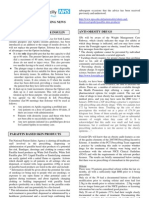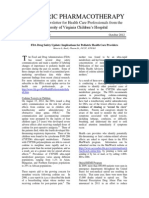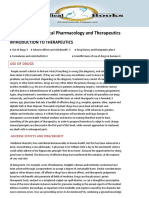0 ratings0% found this document useful (0 votes)
59 viewsOn Demand Clinical Newsletter May
On Demand Clinical Newsletter May
Uploaded by
OnDemandClinicalNewsA recent review has been published online in pain medicine, the official journal of the American Academy of Pain Medicine. Opioid rotation is essentially the switching from one opioid to another or from one route of administration to another. Available data suggests that 50-80% of patients with chronic pain who respond poorly to one opioid improve after being rotated to another opioid.
Copyright:
Attribution Non-Commercial (BY-NC)
Available Formats
Download as PDF, TXT or read online from Scribd
On Demand Clinical Newsletter May
On Demand Clinical Newsletter May
Uploaded by
OnDemandClinicalNews0 ratings0% found this document useful (0 votes)
59 views2 pagesA recent review has been published online in pain medicine, the official journal of the American Academy of Pain Medicine. Opioid rotation is essentially the switching from one opioid to another or from one route of administration to another. Available data suggests that 50-80% of patients with chronic pain who respond poorly to one opioid improve after being rotated to another opioid.
Copyright
© Attribution Non-Commercial (BY-NC)
Available Formats
PDF, TXT or read online from Scribd
Share this document
Did you find this document useful?
Is this content inappropriate?
A recent review has been published online in pain medicine, the official journal of the American Academy of Pain Medicine. Opioid rotation is essentially the switching from one opioid to another or from one route of administration to another. Available data suggests that 50-80% of patients with chronic pain who respond poorly to one opioid improve after being rotated to another opioid.
Copyright:
Attribution Non-Commercial (BY-NC)
Available Formats
Download as PDF, TXT or read online from Scribd
Download as pdf or txt
0 ratings0% found this document useful (0 votes)
59 views2 pagesOn Demand Clinical Newsletter May
On Demand Clinical Newsletter May
Uploaded by
OnDemandClinicalNewsA recent review has been published online in pain medicine, the official journal of the American Academy of Pain Medicine. Opioid rotation is essentially the switching from one opioid to another or from one route of administration to another. Available data suggests that 50-80% of patients with chronic pain who respond poorly to one opioid improve after being rotated to another opioid.
Copyright:
Attribution Non-Commercial (BY-NC)
Available Formats
Download as PDF, TXT or read online from Scribd
Download as pdf or txt
You are on page 1of 2
ProCare HospiceCare
Summer Edition 2012
On-Demand Clinical News
CLINICAL CORNER: Review of Opioid Rotation Practices
A recent review has been published online in Pain Medicine, the official journal of the American Academy of Pain Medicine. The article was published March 28 and reviews the correlation between opioid-rotation and opioid-related deaths. Opioid rotation is essentially the switching from one opioid to another or from one route of administration to another route. The practice is common in pain management as well as the hospice setting when route of administration can change quickly. Available data suggests that 50-80% of patients with chronic pain who respond poorly to one opioid improve after being rotated to another opioid. Another study of patients with chronic non-cancer pain found that 81% of patients required a switch to another opioid with as many as five different extended-release opioids to establish an effective level of pain control with tolerable side-effects. To rotate from one opioid or route to another, clinicians rely in part on opioid equianalgesic tables. These are published tables describing equivalent strengths of one opioid to another (typically using oral morphine equivalents as a standard). As the authors of this recent study explain, there are numerous historical problems with published equivalency tables and for the most part they are lacking in validation. Further, some of the newer opioids may have confusing language in their package inserts. The authors of the study make one point very clear; there is a great deal of inter-patient variability in response to different opioids. Its important to understand the limitations of opioid equianalgesic tables and to consider patient-specific variables such as: age, renal function, prior opioid utilization, or tolerance, to name a few. There are a number of methods to ensure the safe rotation of opioids. In the same journal, the authors put forward a number of precautions clinicians can exercise when rotating opioids, such as tapering the first drug over 3 to 4 weeks while titrating upward on the second. Holding the next dose when a patient presents with sedation or lethargy is another common practice. The hospice setting frequently involves pain management and opioid rotation, and while there are many nuances that make end-of-life care unique, this study provides an excellent review for all clinicians. Also remember, your ProCare clinical pharmacists are always available to assist in interpreting past medical history and current pain management goals to determine the most appropriate opioid for your patients. This article can be found online at: http://onlinelibrary.wiley.com/doi/10.1111/j.15264637.2012.01357.x/abstract
On-Demand Clinical News:
Now Bi-Monthly and Digital!
Thank you for reading this months OnDemand Clinical Newsletter. To improve the flow of information from our clinical team to you, we will now be releasing the newsletter on a bi-monthly basis. In this effort we hope to keep your team informed and up-to-date on all topics ranging from FDA communications to current trends in symptom management. As always, two-way communication is the best means for discussion, so please feel free to ask questions or request new topics as you see fit. We will strive to do our best in making a very useful, very informative, and very exciting newsletter. Aside from the frequency, there are new exciting ways to access the newsletter. Please feel free to visit the Education section of the ProCareHospiceCare.com website. Here you can find the most current On-Demand Clinical Newsletter, as well as previous newsletters from 2009 to present. You can access these newsletters after entering a request for a consult with a pharmacist. Again, please let us know if you have any questions, comments, concerns, or recommendationswe look forward to serving your needs.
FDA Drug Safety Announcement
Celexa (Citalopram) Alert [3-28-2012]
The U.S. Food and Drug Administration (FDA) is clarifying dosing and warning recommendations for the antidepressant Celexa (citalopram hydrobromide; also available in generic form). In August 2011, FDA issued a Drug Safety Communication (DSC) stating that citalopram should no longer be used at doses greater than 40 mg per day because it could cause potentially dangerous abnormalities in the electrical activity of the heart. Citalopram use at any dose is discouraged in patients with certain conditions because of the risk of QT prolongation, but because it may be important for some of those patients to use citalopram, the drug label has been changed to describe the particular caution that needs to be taken when citalopram is used in such patients. The revised drug label also describes lower doses that should be used in patients over 60 years of age. FDA has received post-marketing reports of QT interval prolongation and Torsade de Pointes associated with Celexa and its generic equivalents. In addition, FDA has evaluated the results of a thorough QT study assessing the effects of 20-mg and 60-mg doses of citalopram on the QT interval in adults. The overall summary of findings is presented in Table below:
Increase in the Corrected QT Interval for Citalopram (FDA Analysis) Citalopram Dose 20 mg/day 60 mg/day 40 mg/day Increase in QT Interval (ms) 8.5 18.5 12.6* 90% Confidence Interval (ms) (6.2, 10.8) (16.0, 21.0) (10.9, 14.3)*
*Estimate based on the relationship between citalopram blood concentration and QT interval.
Clinical Question: Rationale for Methadone 5-Day Methadone Checks
By Joelle Potts, PharmD, CGP Q: Why do ProCare HospiceCare clinical pharmacists recommend daily methadone checks? A: We typically recommend doing daily methadone checks for 5 days after methadone is first initiated, and also after any methadone dose increases. The reason is that methadone has a potentially very long and variable half-life, and can take up to 7 days to reach steady state in the body; its peak effect of analgesia is typically seen 3-5 days after continuous PO dosing. In other words, methadone is "short-acting" with its initial dose, and becomes gradually longer-acting with each subsequent dose until steady state is achieved and this is true not only with the initiation of methadone, but with methadone dose increases as well (i.e. the dose increase will also take a few days to become long-acting and reach steady state). For these reasons, we also recommend to wait 5 days between methadone dose increases, so the effects of methadone can be more accurately assessed. The primary reason for daily methadone checks is to assess the patient's pain control (for example, to see if any adjustments need to be made in the breakthrough opioid being used). But they are also used to monitor for potential adverse effects due to methadone, including lethargy/sedation or respiratory depression, which could indicate that the dose of methadone is too high. Both aspects are important to monitor after a dose increase as well, and not just after methadone initiation.
ProCare HospiceCare welcomes all suggestions and comments. If you would like additional information about our services, have ideas for articles, or wish to submit a comment, email us at resources@procarerx.com.
The information provided within this newsletter is proprietary to ProCare Rx. Any reprint or reuse of this information must be approved via written consent.
Copyright 2012, ProCare Rx
3090 Premiere Pkwy., #100, Duluth GA 30097 Editor: Dr. Cody Midlam, PharmD Executive Editor: Dr. Raeanna Lewarne, PharmD
ProCare HospiceCare
You might also like
- Focus On Nursing SEVENTH EDITION PharmacologyDocument2 pagesFocus On Nursing SEVENTH EDITION Pharmacologynanana100% (1)
- Eclinicalworks Emr Medical Assistant & Nurse Training Guide: Rachel J. Cohen PHD Dohmh Training ManagerDocument52 pagesEclinicalworks Emr Medical Assistant & Nurse Training Guide: Rachel J. Cohen PHD Dohmh Training ManagerLaveen Chenna NaniNo ratings yet
- Instant Clinical PharmacologyDocument112 pagesInstant Clinical Pharmacologycelecosib100% (3)
- Pharmacy and Therapeutics Committee Policies and ProceduresDocument11 pagesPharmacy and Therapeutics Committee Policies and ProceduresJedDesabille75% (4)
- Chronic OpioidDocument19 pagesChronic OpioidAnonymous hTivgzixVN100% (1)
- 10 TH Conf Poly PharmacyDocument5 pages10 TH Conf Poly Pharmacytr14niNo ratings yet
- Prescription Writting Class Note 2021-2Document29 pagesPrescription Writting Class Note 2021-2Providence UzomaNo ratings yet
- Hospital Formulary: Astralis Medical GroupDocument36 pagesHospital Formulary: Astralis Medical GroupJade MBNo ratings yet
- IkhsanDocument14 pagesIkhsanSilvia Icha RiskiNo ratings yet
- Study GuideDocument6 pagesStudy Guidekayley.urqNo ratings yet
- Older Adult PatientsDocument6 pagesOlder Adult Patientskurt94764No ratings yet
- The Compliance Following Medical AdviceDocument37 pagesThe Compliance Following Medical AdviceAamna HaneefNo ratings yet
- New Topics in phaRMcology (97-2003)Document18 pagesNew Topics in phaRMcology (97-2003)api-3761895No ratings yet
- Stop Start Toolkit 2013Document14 pagesStop Start Toolkit 2013SantiNo ratings yet
- Medspan's Pharmacy Guide For OSCEDocument8 pagesMedspan's Pharmacy Guide For OSCEDeviselvam100% (1)
- Schizophrenia Treatment & Management - Approach Considerations, Antipsychotic Pharmacotherapy, Other PharmacotherapyDocument13 pagesSchizophrenia Treatment & Management - Approach Considerations, Antipsychotic Pharmacotherapy, Other PharmacotherapydilaNo ratings yet
- Rational Prescribing & Prescription Writing: IntroductionDocument3 pagesRational Prescribing & Prescription Writing: IntroductionAnmol KudalNo ratings yet
- Pdrugs and P TreatmentDocument64 pagesPdrugs and P TreatmentWendz BouvierNo ratings yet
- A Career in The Pharmaceutical SciencesDocument19 pagesA Career in The Pharmaceutical SciencesDrSandeep NarulaNo ratings yet
- Drug Utilization ReviewDocument5 pagesDrug Utilization ReviewWàrìs Ràfìqùé ßàlòçhNo ratings yet
- Safe Administrations of Medications (Draft Chapter)Document74 pagesSafe Administrations of Medications (Draft Chapter)Caleb FellowesNo ratings yet
- lecture-1-introductionDocument10 pageslecture-1-introductionsayyamn2002No ratings yet
- Joy R. Ross Et Al - Clinical Pharmacology and Pharmacotherapy of Opioid Switching in Cancer PatientsDocument10 pagesJoy R. Ross Et Al - Clinical Pharmacology and Pharmacotherapy of Opioid Switching in Cancer PatientsBic0000No ratings yet
- Ing GrisDocument6 pagesIng GrisRaditya PrayogaNo ratings yet
- BPJ64 PolypharmacyDocument11 pagesBPJ64 PolypharmacyLimYouhokNo ratings yet
- Shpa To TG - AnalgesicDocument8 pagesShpa To TG - AnalgesicLui Vey HarNo ratings yet
- Lecture 1 IntroductionDocument8 pagesLecture 1 IntroductionManWol JangNo ratings yet
- Bulletin June2011Document6 pagesBulletin June2011Rema Panickar SugunanNo ratings yet
- Nurse Advise Err 201105Document3 pagesNurse Advise Err 201105grayburn_1100% (1)
- MEDICATIONSDocument16 pagesMEDICATIONSCynthia LuayNo ratings yet
- Cios1830801 PDFDocument2 pagesCios1830801 PDFEmmanuel LawerNo ratings yet
- Review of ADHD PharmacotherapiesDocument9 pagesReview of ADHD PharmacotherapiesannasescuNo ratings yet
- Methadone - OPA GuideDocument20 pagesMethadone - OPA GuideMichelle LiangNo ratings yet
- Lorne Basskin - Practical PE ArticleDocument5 pagesLorne Basskin - Practical PE ArticleCatalina Dumitru0% (1)
- Pharmacy Thesis SampleDocument8 pagesPharmacy Thesis Samplegj6sr6d7100% (2)
- Prescription Drug Abuse ThesisDocument5 pagesPrescription Drug Abuse Thesistpynawfld100% (2)
- Medication Administration by Jennifer MeyeringDocument6 pagesMedication Administration by Jennifer MeyeringRajendra NukalaNo ratings yet
- Vignesh Pernati October 10, 2016 Period 1 Annotated Source ListDocument14 pagesVignesh Pernati October 10, 2016 Period 1 Annotated Source Listapi-334520588No ratings yet
- Practice Standard: Safe Prescribing of Opioids and SedativesDocument4 pagesPractice Standard: Safe Prescribing of Opioids and SedativesSteve GreenNo ratings yet
- Cureatr Ebook MedicationAdherenceDocument35 pagesCureatr Ebook MedicationAdherencemittal kelaNo ratings yet
- Geriatric. 2.Document25 pagesGeriatric. 2.رزق يوسفNo ratings yet
- Clinical PharmacokineticsDocument1,135 pagesClinical PharmacokineticstayhodgesNo ratings yet
- Statins and OverDocument4 pagesStatins and Overlika_09No ratings yet
- Literature Review Medication Safety in AustraliaDocument5 pagesLiterature Review Medication Safety in Australiaea7gpeqm100% (1)
- Potential Strategies WasteDocument14 pagesPotential Strategies Wastetsholofelo motsepeNo ratings yet
- Pediatric PharmacotherapyDocument4 pagesPediatric PharmacotherapyGavril Diana AlexandraNo ratings yet
- Adapted From CDC Guideline: Assess Pain & FunctionDocument2 pagesAdapted From CDC Guideline: Assess Pain & FunctionSolomon Seth SallforsNo ratings yet
- Helping Patients Make The Most of Their MedicinesDocument13 pagesHelping Patients Make The Most of Their MedicinesArif ShikalgarNo ratings yet
- Clinical Therapeutics and The Recognition of Drug-Induced DiseaseDocument4 pagesClinical Therapeutics and The Recognition of Drug-Induced DiseasewaterprincessNo ratings yet
- Contraception Questions and Answers For PharmacistsDocument9 pagesContraception Questions and Answers For PharmacistsMohamed OmerNo ratings yet
- Straka 2015Document12 pagesStraka 2015Floyd balansagNo ratings yet
- PocketGuide FINAL6 PDFDocument2 pagesPocketGuide FINAL6 PDFSolomon Seth SallforsNo ratings yet
- Drug Normalisation DissertationDocument8 pagesDrug Normalisation DissertationUK100% (1)
- Good PrescribingDocument20 pagesGood Prescribingbil sitNo ratings yet
- Antithrombic Medications Vs Antithrombic DevicesDocument7 pagesAntithrombic Medications Vs Antithrombic Devicesapi-240398244No ratings yet
- FLEBUXOSTATDocument12 pagesFLEBUXOSTATdemrik13No ratings yet
- A Textbook of Clinical Pharmacology and Therapeutics PDFDocument6 pagesA Textbook of Clinical Pharmacology and Therapeutics PDFMovie Box MoviesNo ratings yet
- Contrasting Time - and Rate-Based Approaches For The Assessment of Drug-Induced QT ChangesDocument10 pagesContrasting Time - and Rate-Based Approaches For The Assessment of Drug-Induced QT ChangesLuciana OliveiraNo ratings yet
- Modern MedicineDocument9 pagesModern Medicinefrozenmail74No ratings yet
- Caselt 2Document5 pagesCaselt 2Cy PilapilNo ratings yet
- Case Study 1 CasestudiesDocument4 pagesCase Study 1 CasestudiesPrashant MalviNo ratings yet
- Transfersomes: New Dominants For Transdermal Drug Delivery: January 2012Document22 pagesTransfersomes: New Dominants For Transdermal Drug Delivery: January 2012vallentpangalaNo ratings yet
- GETMEDSDocument1 pageGETMEDSSophia ZozobradoNo ratings yet
- Poster (PDF) INDUSTDocument1 pagePoster (PDF) INDUSTsherif.tarek3No ratings yet
- Boris Banas-Bernhard Beitzke-Cannabis Extracts Cannabinoids Legal PerspectivesDocument31 pagesBoris Banas-Bernhard Beitzke-Cannabis Extracts Cannabinoids Legal PerspectivesMichal Tőzsér100% (2)
- Foreign Pharmacy Graduate Equivalency ExaminationDocument26 pagesForeign Pharmacy Graduate Equivalency Examinationnewfakeemail100% (2)
- TrademarksDocument35 pagesTrademarksLe Obm SizzlingNo ratings yet
- NovartisDocument14 pagesNovartisRahul KumarNo ratings yet
- 1Document192 pages1Deta Meila PutriNo ratings yet
- Management of Gastric AcidityDocument23 pagesManagement of Gastric AcidityDharline100% (1)
- m4s Q&as r2 Q&asDocument6 pagesm4s Q&as r2 Q&asklausgreatevilNo ratings yet
- Q.C of Solid Dosage FormDocument37 pagesQ.C of Solid Dosage Formhm01010957093No ratings yet
- Tabel Medicamente 20.08.2019Document3 pagesTabel Medicamente 20.08.2019Eva.lineNo ratings yet
- IPTS E BookDocument327 pagesIPTS E Bookscanozturk48No ratings yet
- The Use of Medication Against Attention Deficit:hyperactivity Disorder in Denmark: A Drug Use Study From A Patient PerspectiveDocument11 pagesThe Use of Medication Against Attention Deficit:hyperactivity Disorder in Denmark: A Drug Use Study From A Patient PerspectiveDanilo Borges Dos SantosNo ratings yet
- MaserasiDocument6 pagesMaserasiErna YulidaNo ratings yet
- Injeksi IntratimpanikDocument4 pagesInjeksi Intratimpaniknurhalimah NasutionNo ratings yet
- PPDH Cara Penulisan Resep Obat KardiovaskularDocument35 pagesPPDH Cara Penulisan Resep Obat Kardiovaskulardiana fatwaNo ratings yet
- Antiretroviral Therapy (ART)Document41 pagesAntiretroviral Therapy (ART)Ashik Jithu JohnNo ratings yet
- Med Admin Practice QuestionsDocument5 pagesMed Admin Practice QuestionsArmelle DelvaNo ratings yet
- KVAFSU (Shivamogga) - Question BankDocument361 pagesKVAFSU (Shivamogga) - Question BankKishore SenthilkumarNo ratings yet
- Related Discussion On Quality ControlDocument6 pagesRelated Discussion On Quality ControlRea CastilloNo ratings yet
- Prof. Agdo. Dr. Alejandro Goyret Departamento de Farmacología y TerapéuticaDocument16 pagesProf. Agdo. Dr. Alejandro Goyret Departamento de Farmacología y TerapéuticaJavier Alexander Ito ApazaNo ratings yet
- Jadwal PKP Angkatan 6 New-13 Maret 2020Document48 pagesJadwal PKP Angkatan 6 New-13 Maret 2020Humaira AzzahraNo ratings yet
- Gtu M.pharm Thesis Guidelines 2015Document6 pagesGtu M.pharm Thesis Guidelines 2015fjez64hr100% (1)
- Morocco:: CapitalDocument8 pagesMorocco:: CapitalPurva ChandakNo ratings yet
- Tourettes Fact SheetDocument4 pagesTourettes Fact SheetCody HawleyNo ratings yet
- Indent For IssueDocument2 pagesIndent For Issueindum5670No ratings yet





